Assisting Mother Nature
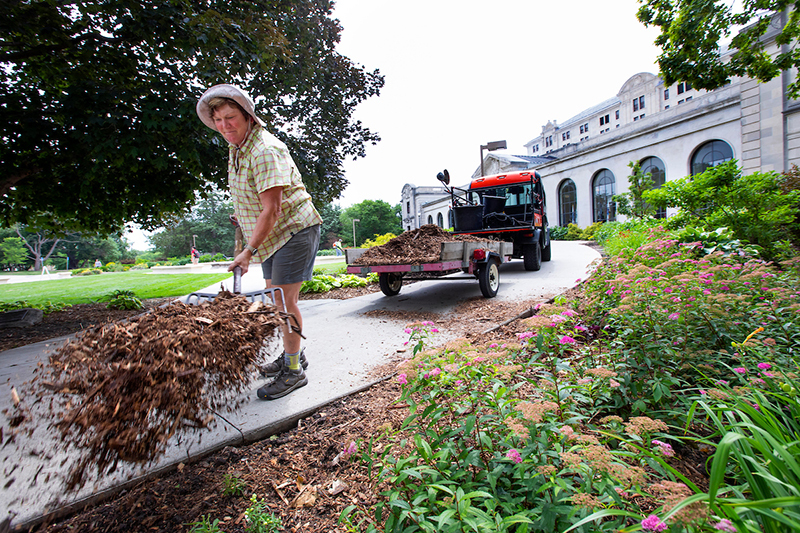
Photo by Christopher Gannon.
Mary Schrunk, groundskeeper with campus services, spreads mulch over a bed of plantings outside the Memorial Union earlier this week. She is in charge of the landscaping surrounding the Fountain of the Four Seasons and the MU north lawn, which sees lots of foot traffic during the new student orientation season. "I get some help from Mother Nature, too," Schrunk insisted, humbly.
Where the Principles of Community came from
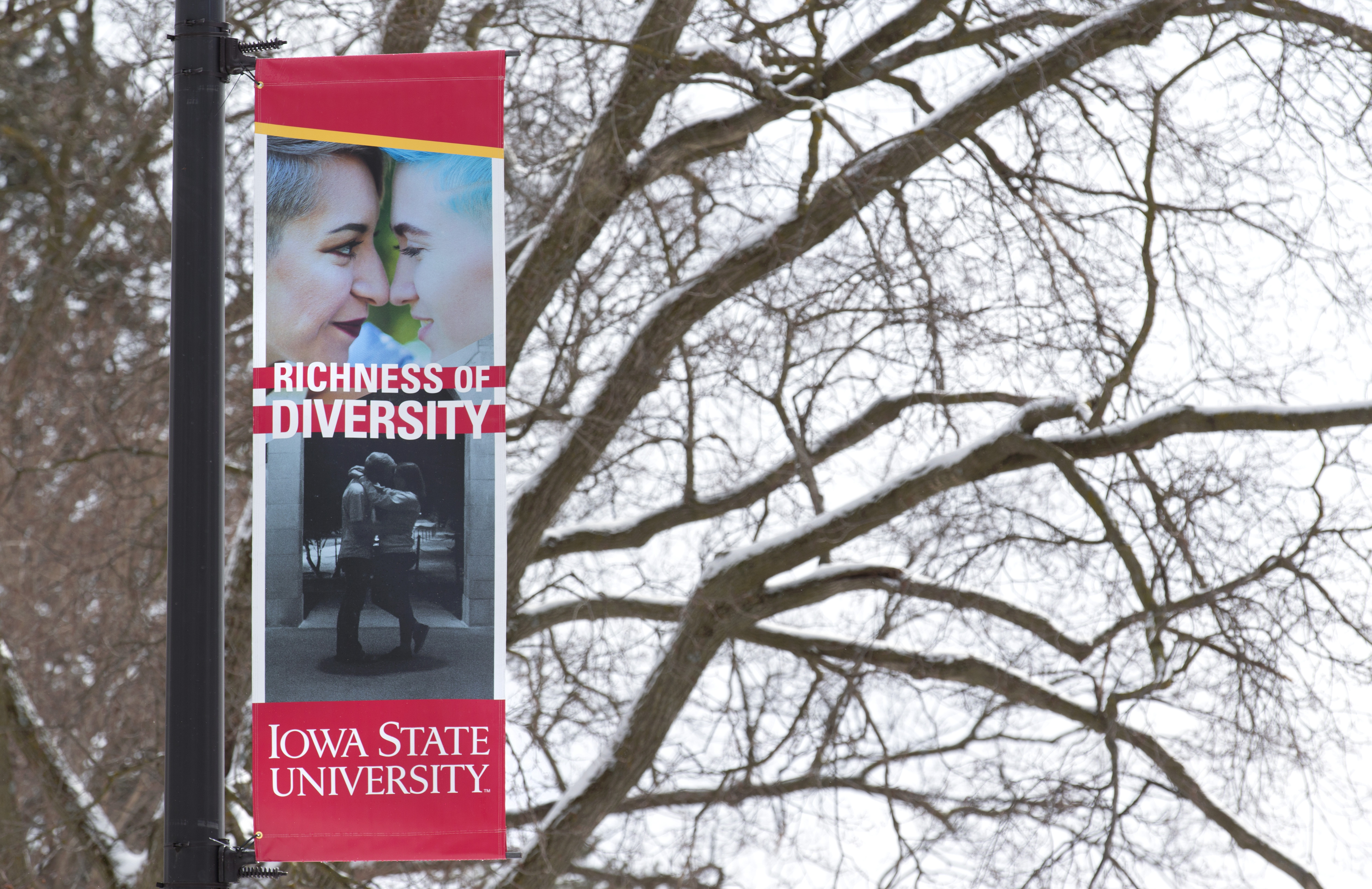
A banner depicting one of the six Principles of Community displayed on Morrill Road near the Memorial Union in 2018. Photo by Christopher Gannon.
At Iowa State, the Principles of Community are ubiquitous. They're emblazoned on streetlight banners and hang on the walls of academic buildings and residence halls. They show up in job advertisements, remarks by senior leaders, course syllabi, campus video and website content, and orientations for students and employees alike. The six principles are the messaging bedrock for cultivating inclusion at the university.
That's exactly what Phil Hernandez had in mind 16 years ago -- a simple set of values interwoven into everything.
"Whether it's student conduct or hiring or a difficult conversation, professionals and students can see what the foundation is. It can all come back to the principles. It seems like it's getting there," said Hernandez, co-chair of the group that wrote the principles.
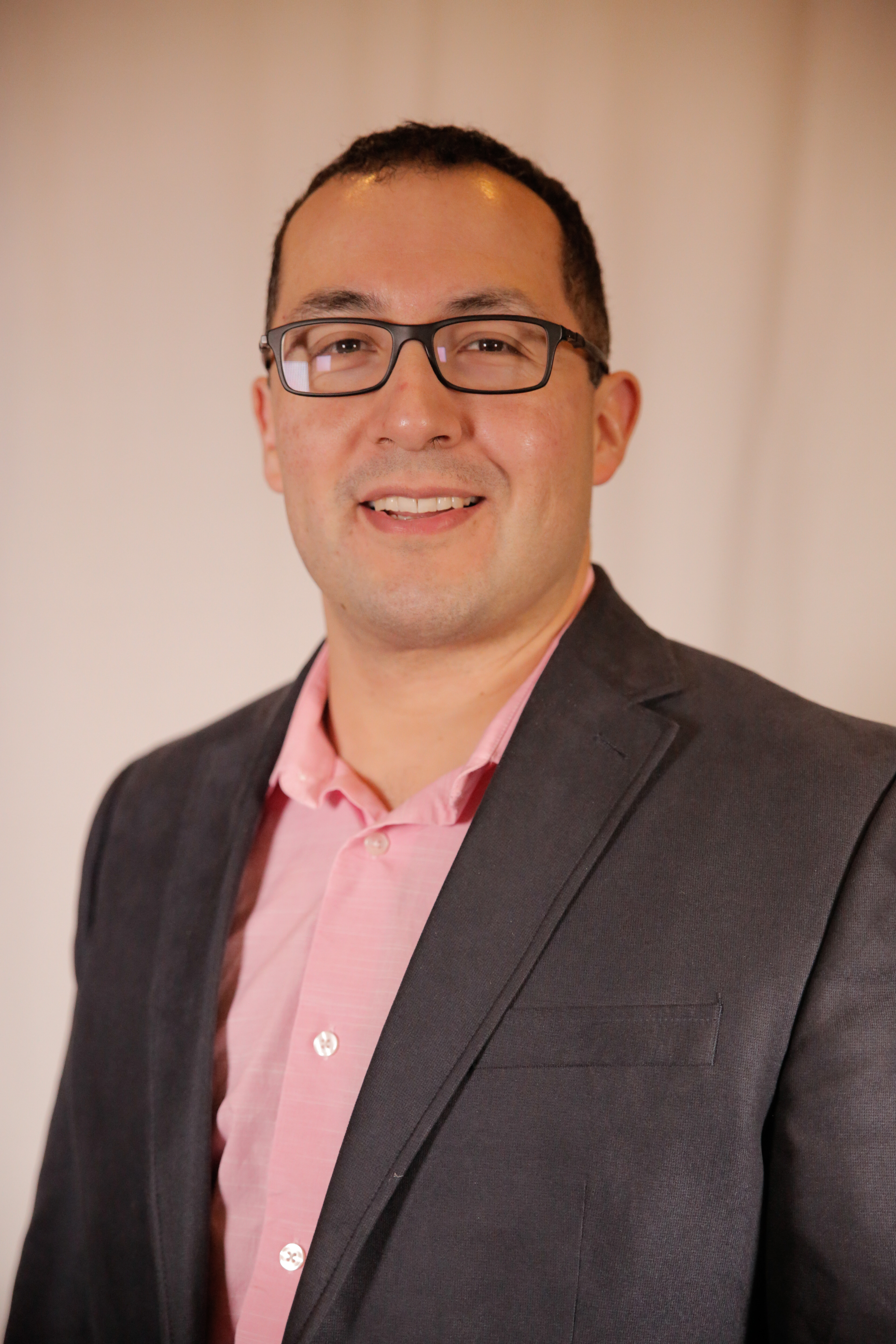
Phil Hernandez
Responding to hate
Now the director of residential life and housing at Green River College in Auburn, Washington, Hernandez was a graduate student in Iowa State's educational leadership and policy studies program in 2005. Over a long July 4 weekend that summer, someone spray-painted hateful homophobic, sexist and antisemitic messages on numerous campus buildings.
Hernandez was shocked and embarrassed. It didn't square with the esteem he had for Iowa State, a place he cherished so much in his two years of master's degree studies that it feels like he's in church when he returns to visit campus. As a student government senator, he pushed the student government to establish a commission to draft the principles in response to the graffiti attack. He'd picked up the idea in his internship that summer at the University of California, San Diego, where the institution's community principles were ever-present.
"You could not throw a stick without hitting a poster about their principles of community," he said.
Hernandez was appointed to co-chair the commission, along with Penny Rosenthal, director of the Sloss Center for Women and Gender Equity, one of the targets of the vandalism. The commission held focus groups in fall 2005, interviewing students, faculty and staff about what makes a community inclusive. Comments were categorized and distilled into a form similar to the principles eventually adopted: respect, purpose, cooperation, richness of diversity, freedom from discrimination, and honest and respectful expression of ideas.
"It's sad that the catalyst for something like this is often really negative, dangerous and even violent," said Rosenthal, whose last name at the time was Rice. "But sometimes motivation comes from a not-so-great thing."
A smooth process
To bolster the commission's proposal to President Gregory Geoffroy, members met with every campus group possible, collecting dozens of letters of support that included endorsements from Faculty Senate, the Professional and Scientific Council, every college dean, the Ames City Council and a wide swath of student organizations.
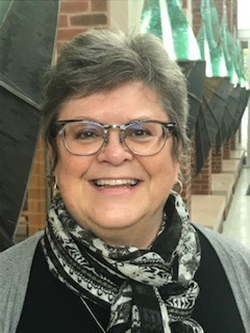
Penny Rosenthal
"Every committee and every governing body we went in front of approved it. It was a lot of, 'Well, duh, of course!'" Rosenthal said.
Rosenthal, now the director of advocacy services at Riverland Community College, Austin, Minnesota, was excited by how smoothly and quickly something so potent came together. She once was told a university the size of Iowa State moves like an ocean liner, whereas she corners like a Corvette. It was nice to get to do some laps on the deck of the ocean liner for once, she said. She considers developing the principles one of her fondest memories and pride points -- right up there with seeing her children graduate college in four years.
"I don't know that there's anything more powerful I've done when I look back at my 24 years in higher ed," she said. "Think about what this does for anybody who feels targeted. It's an indicator of culture that shows this will be a place where they can feel safe."
Keeping it simple
The principles are powerful in large part because they use casual language and express straightforward concepts, Hernandez and Rosenthal said.
"I honestly believe that if you attended every day of kindergarten, you would know all of the principles," Rosenthal said.
That simplicity makes the principles more useful, Hernandez said. They can be noticed, recalled and referenced in helpful moments instead of being buried in a planning document or mission statement.
"It levels the playing field between students, administrators, faculty members and staff and gives the space to have an awkward conversation. It's not cerebral. Most institutions identify core values, but they do it in such a cerebral way," he said.
At the time the principles were being developed, there also was an ultimately unsuccessful effort to create a student honor code, Rosenthal said. That contrasted with the Principles of Community, which are more proactive than prohibitive. Rosenthal prefers the affirming way.
"You get the behavior you desire by positively reinforcing it," she said.
Looking back
Rosenthal said she's surprised more colleges and universities don't have something like the Principles of Community. She's tried to launch similar initiatives at other schools, and none of them embraced the concept.
"It's not common, and that doesn't make sense to me," she said.
Though approved by Geoffroy in 2007, the principles weren't fully embraced at Iowa State for several years, either. President Steven Leath reintroduced them in 2016, during the charged political environment of that fall's presidential race. Their use has expanded in the years since.
"It wasn't as 'wow' as I'd hoped right away. It has to be the right leaders and the right time," Rosenthal said.
Rosenthal was aware the principles had become more prominent since she left Iowa State in 2011, but Hernandez only recently learned how high-profile they are now, a realization that was satisfying and a bit overwhelming. It's also a reminder, he said, that students can effect change, as can community dialogue.
"It was time-consuming, but it wasn't messy. It was time-consuming, but it brought people together. It was time-consuming, but it went all the way to the top," he said. "Whatever anyone's political opinion is, the last five years have demonstrated what happens when we don't have that."
If you'll need a passport, apply now
As pandemic precautions lift, international travel plans are bound to become more common for faculty, staff and students. Anyone who has "securing a valid passport" on their travel to-do list should apply now.
The current processing time for new passport and renewal applications is much longer than usual, said Frank Peters, director of the Study Abroad Center. Regular applications are running about 18 weeks and expedited applications are taking 12 weeks, according to the U.S. Department of State.
"Nobody needed one for a year, so there is a backlog," Peters said.
A small number of ISU students will be studying abroad this fall, including 45 in the College of Design's Rome program and another 20 in various programs, Peters said. He's hopeful that many more programs will be available during the spring semester. In a recent email to students, he urged those considering spring semester or spring break programs to apply for a passport by July 10 and to choose the expedited processing option.
Passports must be valid for six months after the anticipated end of travel, Peters said. Getting a passport early is especially important for trips that require a visa, as the processing times for visas are longer than usual, as well.
To apply for a first-time passport or to replace or renew a passport that was lost, stolen, damaged, issued to someone under age 16 or issued more than 15 years ago, go to a passport acceptance facility, such as the Ames Post Office. Application requirements and fees are listed online. Adults renewing a passport issued within the past 15 years can renew by mail.
Reminder to register
Under a policy established at the start of 2020, all ISU-sponsored international travel must be registered with the risk management office. The requirement ensures travelers are insured and connects them with useful resources. The policy also defines what qualifies as university-sponsored travel.
Because of the pandemic, travel to most international destinations remains high-risk, which requires an itinerary review by risk management. Email intlrisk@iastate.edu or call 294-6916 to arrange a review. When registering an international trip, faculty, staff and students must agree to follow all health and safety regulations of any country they are visiting.
Here's your chance: Tell IT what you need for data storage
With the goal of providing the best-fitting storage solutions for the university, information technology (IT) units across campus and a storage advisory committee want to know how and where employees and students store electronic files. So, they're asking.
Starting today, a customer survey is available on IT's Storage@ISU website, and the committee is asking every faculty and staff member and student to complete it.
Recent moves by storage vendors Box and Google to cap storage capacities for higher education clients started a broader discussion about campus storage needs, said committee chair Jason Shuck, who manages IT's systems operations team, which oversees data storage. Storage for electronic files has evolved dramatically in the last five years, he noted, particularly for research and video storage needs.
"We need to figure out as an institution what we're doing with storage so we can serve our customers. We have solutions we think would work, but we need members of the campus community to tell us what they're doing with storage, what they need it to do and what they want it to do," he said. "Then, we can determine if we have a solution to fit those needs today or if we need to pivot and find something that's a better fit."
Don't let the length deter you
It's not a two-minute survey -- each of seven sections contains 3-28 questions -- but that's mostly because it's the first time ITS is asking about data storage needs and there are a lot of things they hope to learn, Shuck said. The majority of staff, faculty and students won't need to complete all seven sections -- survey logic filters will guide each respondent through it -- but Shuck really wants everyone to open the survey and answer the sections relevant to their university work or studies.
"We want everyone to participate -- those for whom storage is a top priority as well as those who never really think about data storage as part of their job. Everyone is part of this equation," he said.
The sections inquire about:
- Demographics: Who are you and how much data do you create?
- Collaboration: Do you work with other people (inside, outside of ISU) on your data?
- Data access: How do you get to your data and why?
- Composition (includes a subsection on multimedia data): What kinds of data do you create or use?
- Compliance: Do you work with data that requires compliance controls?
- Data recovery: How do you back up your data and how long do you need to keep it?
- Research storage: How much raw data do you generate and do you have unique requirements?
The survey asks respondents to distinguish between needs and wants, and to be honest about the distinction, Shuck said. It also asks respondents to answer for their use, not a unit or center or department.
The survey is anonymous and can be completed in multiple sittings, Shuck said. It shouldn't take more than 20 minutes to complete, and includes an option to provide an email address, which only would be used if the data storage team wanted to follow up on answers provided. Nearly all questions are multiple choice, but survey respondents may provide more information in open questions that ask what they like most/least about their current storage service.
How your input will be used
Shuck said the advisory committee and IT teams will prepare a summary report to be shared with IT leaders and used to shape decisions for the long term about storage solutions -- whether free or purchased -- that respond best to the survey results. The need vs want analysis -- and the possibility of achieving both -- would be part of the assessment, Shuck said.
Another goal is to develop a solutions matrix that could be used as data storage needs emerge or change among members of the campus community, he said. It would contain storage needs serviced, price (if any) and information links for would-be users.
Regents propose 3.5-3.9% tuition increases for fall
Following a freeze this year on all tuition and fee rates, the state Board of Regents is considering a 3.5% tuition increase for resident undergraduates this fall (3.9% increase for all others). With a package of mandatory student fees that would increase about 2.8% ($36), the impact is $318 (3.4%) more this fall for resident undergraduates, $418 (3.8%) for resident graduate students, $942 (3.8%) for nonresident undergraduates and $1,000 (3.9%) for nonresident graduate students.
The increases are higher for upper division students in academic programs that assess supplemental tuition to cover higher instructional costs. The proposed increases for professional Veterinary Medicine students are $982 (3.8%) for residents and $2,116 (3.9%) for nonresident students.
The regents held a first reading, without questions or public discussion, of the tuition proposal during a June 24 virtual meeting. The second reading and vote is anticipated at the group's July 28 meeting.
The proposal aligns partially with tuition "guardrails" the board approved in fall 2018 that link tuition increases to the Legislature's support for the universities' funding requests; higher state funding equates to lower tuition increases and vice versa. According to that plan, when the Legislature's funding remains flat, resident undergraduate tuition would increase 3 percent plus the projected HEPI (Higher Education Price Index), for which the FY22 projected midpoint currently is at 2.1%, according to the University of Iowa's economics department.
Proposed tuition and mandatory fees*
|
|
2021-22 proposed |
Increase over 2020-21 |
|
Undergraduate |
|
|
|
Resident |
$9,633.90 |
$318 |
|
Nonresident |
$25,445.90 |
$942 |
|
Graduate |
|
|
|
Resident |
$11,403.90 |
$418 |
|
Nonresident |
$26,947.90 |
$1,000 |
|
Veterinary Medicine (DVM) |
|
|
|
Resident |
$26,475.90 |
$982 |
|
Nonresident |
$56,693.00 |
$2,116 |
*Base rates; doesn't reflect differential tuition.
As part of its June 24 discussion, the regents invited comments from student government leaders at the three universities.
ISU student government president Julia Campbell reminded board members that the state's investment in public education pays off in a skilled workforce, lower unemployment rates, higher tax revenue and fewer demands on government-funded social services.
"In the wake of the pandemic, we want to have as minimally disruptive an impact on students as possible, many of whom are struggling financially. Given current fiscal constraints, there's not a realistic way to maintain the level of education we experience without cutting campus services or increasing tuition," Campbell said.
Speaking to the proposed increase for fall, she said, "We are asking that it be as small an increase as possible to still allow us to maintain the exceptional level of education our regent institutions have offered for generations. While we realize education is an investment in our future, we want to reduce and mitigate unnecessary financial burdens developed during this time.
"As long as the Board of Regents stays true to the mission of providing diversified and high-quality educational offerings at a reasonable cost, the best decision will be made," she added.
Board president Mike Richards thanked the students for their leadership and assured them "the regents really do try to keep the cost to the students as low as we can and still keep the quality up there where it belongs."
Differential tuition, simplified
Iowa State first assessed differential tuition during the 2006-07 academic year, for upper division students in the College of Engineering. Since then, it has phased in differential tuition for other upper division students, fourth-year professional Veterinary Medicine students and graduate students in programs that are more costly to deliver -- rather than spread the costs across the entire student body. A three-year, $500/year increment for all nonimmigrant, noncitizen international students began in 2015-16 to recover the extra costs of admitting, advising and providing additional services for them. In 2018-19, the university began a three-year plan to align the various differential tuitions in two levels, labeled as A and B, to simplify the structure. With last year's tuition freeze, that process would wrap up in the new academic year, except for the final year (of three) to phase in differential tuition for sophomores in agricultural systems technology, industrial technology and all Engineering programs.
Changes to mandatory fees
Iowa State is requesting an increase of $36 to its student fees package that would bring it to $1,309.90. That reflects:
- $263 health fee, an increase of $23, to maintain high quality, accessible care for students at Thielen Student Health Center
- $6 health facility preventive maintenance fee, a decrease of $10 redirected to the health fee
- $252.20 student services fee, an increase of $19, for CyRide labor and fuel increases
- $89.10 student union building fee, an increase of $4, to address deferred maintenance
- $321.60 recreation fee, no change
- Variable technology fee, by program (range is $244-$506), no change
Increases to common student fees
Separate from mandatory fees, students pay common fees only for services they need or request, for example application fee or thesis fee. Iowa State proposes to change two of several dozen:
- Enrollment fee for graduate students would go up 3.9%, from $543 to $564. This is consistent with the tuition increase rate.
- Continuing education rates (per credit hour) would be assessed from a dollar range, to offer some flexibility and recover the costs of offering each program to off-campus or online learners. The undergraduate rate would increase from $336/credit hour to a range of $348-1,214/credit hour. The graduate rate would increase from $543 to a range of $564-$1,705.
Technology reminders for returning to campus
If you're returning to campus after being away for an extended time, here are a few tips and reminders to get your technology tools back in action.
First things, first. In addition to your basic computing equipment, remember to bring your power supply, cables, adapters, docks, mice, keyboards and any other equipment items when you return to campus. If you set up call-forwarding on your campus phone, you might also wish to turn off that setting.
If it's been some time since you've logged in from campus, updates may need to install and, depending on the status, this may take some time. To confirm your computer is up to date with Windows or MacOS software, refer to this article, "Microsoft Office: Get Microsoft Office Updates for Windows and MacOS Devices" for assistance. To access the Iowa State network, you also may need to update your eduroam certificate (don't worry, it's easy!). Refer to this article, "Wireless Internet: Connect to the Eduroam Network."
In a shared office space, check with your local IT staff or designate a person to confirm printers are working correctly. Refer to this resource, "Print: Connect to a Campus Printer," to troubleshoot any issues. Refamiliarizing yourself or unit with AV equipment that is operational in department conference rooms will also help with the transition back to campus. A few other items to consider include verifying any software licensing needs and reviewing warranty timelines for equipment.
When logging onto the network, some faculty and staff may encounter an issue stating, "The trust relationship between this workstation and the primary domain failed." If this occurs, contact the IT Solution Center or your local IT professional. A systems administrator will add your computer back to the domain or re-enable your computer to correct this issue.
Many additional back-to-campus articles and resources are available on the IT portal. For other topics, search the knowledge base and follow the self-service guidance. If you need additional assistance, submit a ticket to the IT Solution Center following these tips, "Get Help: How to Submit an Issue to the IT Solution Center."
Welcome back to campus!
New platform allows online requests for FPM, EHS services
A system that launched July 1 will allow all faculty and staff to submit online service requests to facilities planning and management (FPM) and environmental health and safety (EHS).
The new platform, FAMIS 360, is the updated, cloud-based version of the FAMIS software FPM had used since 1999 to manage work and purchase orders, inventory, space, inspections, keys, utilities and other assets. (FAMIS stands for Facilities Asset Management Information System.)
Faculty and staff previously had to be on a list of approved requesters to submit an FPM service request online, a requirement established to make the custom system more manageable. But with FAMIS 360's built-in online submission function, it's easier to open up the online request option to all employees, said Kris Koerner, FAMIS manager for FPM. Starting July 1, employees can access FAMIS 360 by adding the app to their Okta login page using the search bar at the top of the page.
"This will be new for lots of people," Koerner said.
Status updates available
Users will receive updates on their service requests and can send messages related to the requests within the system, new features that will be appreciated, said Jody Danielson, FPM business services director.
"Customers really want to know the status of a request because that's what we're used to for everything else in life," she said.
Any service FPM provides can be requested through FAMIS 360, from routine maintenance to initiating a project. FPM service center staff will let faculty and staff know if a request requires an identified funding source. EHS requests listed as suggestions in FAMIS 360 include ergonomic evaluations, safety training, waste disposal, and services related to automated external defibrillators and fire extinguishers.
Employees can still call the FPM service desk at 294-5100 or EH&S at 294-5359 to submit a service request. Just like online submissions, requests made by phone will generate email updates and an opportunity to correspond within the FAMIS 360 system. Non-employees such as students and visitors can continue to use the "report a problem" online form or call the FPM service desk if they notice issues on campus that need attention.
Other benefits
FPM began the process of replacing the classic version of FAMIS in fall 2019. The platform, which FPM developers had added about 300 customizations to over the years, was built with aging code and wouldn't be supported by the vendor at the same level in the future, said Ayinde Popo, FPM information technology manager. The bid was awarded in mid-2020, and the implementation team started its work last fall.
In addition to improving the experience for users submitting service requests, FAMIS 360 integrates with other university systems, such as Workday, and includes a business intelligence tool that will allow FPM IT staff to present customized data in a more modern and visual layout, Popo said.
"It's going to be a lot more efficient," he said.
New software for managing documents and payments for projects went live at the same time as FAMIS 360, which made launching both software programs more complex. About 100 people on campus worked on implementation, including a core team of about 40, Popo said.
"There are so many people who came together to make this successful," he said.
Training and tipsheets
FPM added three self-help articles to the ISU Service Portal to help faculty and staff navigate FAMIS 360: an introduction and guides for creating a request and viewing requests and adding comments.
A video demonstration also will be available later this summer, Koerner said.
Join the celebration of Iowa State's public art
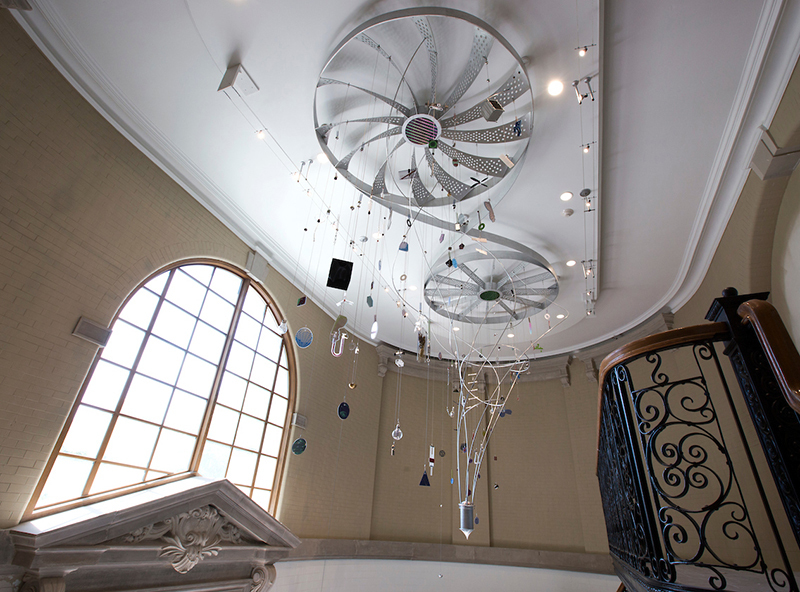
An inverted replica of the Marston water tower is one of many mixed-media, dangling pieces in artist Norie Sato's new "Fifth Muse" in the Marston Hall atrium in 2016. The sculpture was commissioned by university museums and as an Art in State Buildings project for the building's renovation. "Fifth Muse" also is part of Iowa State's public art collection. File photo by Christopher Gannon.
Iowa State's Art on Campus collection contains more than 2,500 public works of art -- indoors and outdoors -- making it one of the largest campus public art programs in the United States. A July 9 celebration will focus on that collection in five 45-minute tours led by university museums staff and volunteers. Each will consider a different theme and different works of art on campus.
Education and visual literacy curator Lilah Anderson said summer is a great time to highlight and access the public art collection. With a smaller group of students on campus, it's also a good time to offer programs for their faculty/staff and Ames community audiences, she said.
What makes it public?
Most of the Art on Campus collection is on exhibition all the time and publicly accessible. Another feature that sets the collection apart is that many pieces were acquired through a public process, in which a campus committee wrote a public art statement, helped select an artist and worked with the artist on the overall idea to be represented in the new piece.
Maquoketa artist Rose Frantzen's mural in the Gerdin Business Building addition, installed earlier this month and included in Sydney Marshall's 11 a.m. tour July 9, is the latest example of the public art process.
The five tours are free and open to the public; registration is requested (see links below). Masks are encouraged for those who are not yet vaccinated against COVID-19.
July 9 guided tours
-
9-10 a.m., Campus Beautiful, begins at the Bighorn sculpture in the Elizabeth and Byron Anderson Sculpture Garden south of Morrill Hall, register
Director and chief curator Lynette Pohlman explores the evolution of the Art on Campus collection. An aesthetically beautiful campus was a top priority for university founding members Adonijah Welch and Peter Melendy. -
11 a.m.-noon, Recent Art on Campus Acquisitions and Collection Care, begins at the Bighorn sculpture in the Elizabeth and Byron Anderson Sculpture Garden south of Morrill Hall, register
Curator Sydney Marshall will provide insight to caring for the 2,500-plus works of art in the collection, located in buildings, courtyards, open spaces and classrooms. -
Noon-1 p.m., Science and Art in the Art on Campus Collection, begins at the south entrance of the Molecular Biology Building, register
Curators Adrienne Gennett and Allison Sheridan will explore the intersections of art and science within the collection and how creativity and knowledge from one impacts the other. -
1-2 p.m., Art on Campus Highlights, begins at the Janus Agri Altar sculpture in the Agronomy Hall courtyard, register
In an introduction of sorts, docent Rae Reilly reviews some of the iconic works of art in the collection. -
3-4 p.m., Women Artists in the Art on Campus Collection, begins at the Bighorn sculpture in the Elizabeth and Byron Anderson Sculpture Garden south of Morrill Hall, register
Female artists are widely represented in the collection, and interpretative specialist Brooke Rogers delves into the unique women who have made their mark on Iowa State's artful campus.
